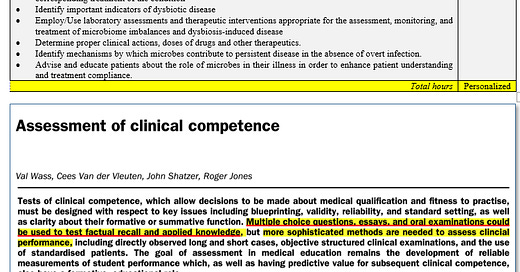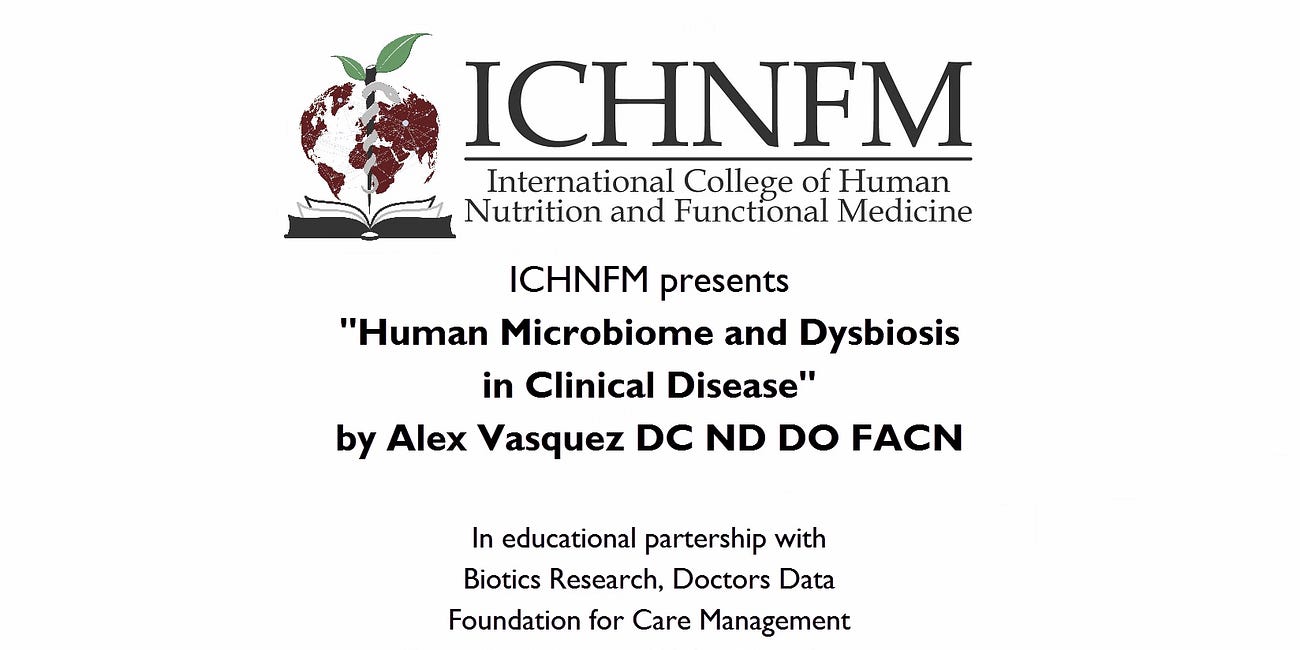Can you answer these 10 questions on dysbiosis and microbiome?
I will post a video review of these QUESTIONS and ANSWERS this weekend [SUBSCRIBERS]
All videos from the course HUMAN MICROBIOME AND DYSBIOSIS IN CLINICAL DISEASE are being re-uploaded in Feb-Mar 2025 to provide direct and reliable access through the substack platform:
Can you answer these 10 questions on dysbiosis and microbiome?
VIDEO with discussion of QUESTIONS and ANSWERS 1-5 with Test-Taking Strategies
QUESTIONS and ANSWERS for Dysbiosis & Microbiome (6-10) with Test-Taking Strategies
Microbiome Dysbiosis (1) Course Overview and Introduction to Major Concepts and Mechanisms
Microbiome Dysbiosis (2) Physiologic and Pathologic Mechanisms of Dysbiosis and Subclinical Microbial Colonizations (VIDEO:1hour,15minutes)
Microbiome Dysbiosis (3) Prototypes of Dysbiosis-Induced Disease (VIDEO:1hour,42minutes=102minutes)
Microbiome Dysbiosis (4) Conceptual Expansion Exploring Clinical Testing, Microbial Relevance and Irrelevance [VIDEO:1hour,18minutes=78minutes]
Microbiome Dysbiosis (5) Microbial Consequences in the Mouth, Oral Cavity [VIDEO:1hour,44minutes=104minutes]
Microbiome Dysbiosis (6) Microbial Imbalances in the Respiratory Tract and Sinuses [VIDEO:1hour,35minutes=95minutes]
Microbiome Dysbiosis (7) Dysbiosis by Location—Genitourinary Tract
Microbiome Dysbiosis (8) Dysbiosis by Location—Blood, Tissue, Parenchymal Dysbioses
Microbiome Dysbiosis (9) Dysbiosis by Location—Skin and Environmental Dysbiosis
and several other videos for many hours more—these will be posted progressively over the next few days into March2025
Sample questions:
1. A young child is brought to your office for treatment of eczema. Atopic dermatitis is commonly known as eczema and is generally treated with antiinflammatory agents (e.g., "steroid cream"), antihistamines, immunosuppressants, immunomodulators, and moisturizers. Patients with atopic dermatitis show increased production of IgE and histamine following exposure to which of the following microbes, and eradication of this microbe via the use of antimicrobials (eg, cephalexin, diluted hypochlorite baths) results in clinical alleviation:
A. Candida albicans
B. Saccharomyces boulardii
C. Streptococcus pyogenes
D. Pseudomonas aeruginosa
E. Staphylococcus aureus
F. Klebsiella pneumoniae
G. Escherichia coli
2. Your patient developed an autoimmune disorder following an infection. Amino acid homology produces molecular mimicry, which is necessary for the resultant immune cross-reactivity. Cross-reactivity between sequences in Acinetobacter and Pseudomonas aeruginosa is most relevant for patients with:
A. Chronic fatigue syndrome / systemic exertion intolerance
B. Fibromyalgia
C. Ankylosing spondylitis
D. Neuritis
E. Atopic dermatitis
F. Psoriasis
G. Antiphospholipid antibody syndrome
3. Your patient presents with persistent nasal congestion and crusting and had a recent event of hemoptosis. ANCA-associated vasculitis (formerly Wegener’s granulomatosis, also called "granulomatosis with polyangiitis") is a life-threatening autoimmune/vasculitic disease which is most commonly associated with colonization/dysbiosis of which of the following microbes, which produces an antigenic acid phosphatase enzyme which haptenizes to vascular endothelial cells to create an immunogenic neoantigen:
A. Candida albicans
B. Saccharomyces boulardii
C. Streptococcus pyogenes
D. Pseudomonas aeruginosa
E. Staphylococcus aureus
F. Klebsiella pneumoniae
G. Escherichia coli
4. A radiologist asks you about the mechanism of action and clinical benefits of probiotics. Probiotic foods and prebiotic nutritional supplements have gained wide popular and professional use and acceptance over the past several years. Which of the following are expected to be increased by administration of probiotic bacteria:
A. Superantigens and LPS and IL-10
B. BactDNA and H2S and p-cresol
C. Butyrate and p-cresol and tyramine
D. Superantigens and p-cresol
E. Butyrate and IL-10 and Treg
F. Th17 and IL6
5. Your patient has suffered from a debilitating illness for many years. Which of the following conditions is most noteworthy for being characterized by SIBO, mitochondrial impairment, neuroinflammation (“brain inflammation”) and deficiency/insufficiency of L-tryptophan and co-enzyme Q10 (ubiquinone):
A. Chronic fatigue syndrome / systemic exertion intolerance
B. Fibromyalgia
C. Ankylosing spondylitis
D. Neuritis
E. Atopic dermatitis
F. Psoriasis
G. Antiphospholipid antibody syndrome
6. Your patient has a persistent inflammatory/metabolic disease. The microbial stool analysis did not show evidence of inflammation or dysbiotic colonization, and you suspect the presence of a nonculturable microbe. Segmented filamentous bacteria have been found in the gastrointestinal tract of humans and are specifically and most importantly noted to increase which of the following:
A. Superantigens
B. BactDNA
C. Butyrate
D. P-cresol
E. Treg cells
F. Th17 cells
G. B cells
7. Your patient wants to be informed of options to hypoglycemic drugs for the treatment of diabetes. The antidiabetic effect of metformin is most similar (clinical effectiveness, impact on microbiome) to which of the following treatments:
A. Artemesinin
B. Oregano
C. Berberine
D. Rifaxamin
E. Vitamin D
8. Microbe-induced disorders can be treated with a variety of strategies, including antimicrobial therapy. Eradication of Staphylococcus aureus in the nares is most affordably, safely, and effectively accomplished by which of the following:
A. Trimethoprim-cotrimoxazole
B. Cephalexin
C. Povidone iodine
D. Mupirocin
E. Vancomycin
F. Metronidazole
9. The ability to achieve sustained remission in rheumatoid arthritis is impressively low with the use of current immunosuppressive and antiinflammatory drugs (Prince et al. Sustained rheumatoid arthritis remission is uncommon in clinical practice. Arthritis Research & Therapy 201214:R68 doi:10.1186/ar3785). In the treatment of the orodental dysbiotic component of rheumatoid arthritis, the most important initial component of the treatment plan, for reducing pain and inflammation, is scaling and planing. Improving orodental health has been shown to reduce pain and inflammation in patients with rheumatoid arthritis. While some of the benefit is via nonspecific reductions in gingival permeability and bacterial inflammogen load/absorption, the specific goal is to reduce/eradicate Porphyromonas gingivalis because of its production of which of the following?
A. Peptydil-arginine deiminase
B. Transglutaminase
C. Acid phosphatase
D. Peptidase
E. Protease
F. Beta-glucuronidase
I will post a video review of these QUESTIONS and ANSWERS this weekend
10. Microbial molecules are capable of inducing a wide range of human physiologic disruption. Which of the following microbial molecules is noteworthy for its abilities to 1) promote systemic inflammation, 2) increase intestinal permeability, 3) impair cytochrome p450 "detoxification" enzymes, 4) impair mitochondrial function and ATP production, and 5) promote pain sensitization via peripheral and central mechanisms:
A. Lipoteichoic acid
B. Lipopolysaccharide
C. Acetate
D. Peptidoglycan
E. Bacterial capsule
Microbiome Dysbiosis (1) Course Overview and Introduction to Major Concepts and Mechanisms
UPDATE February-March 2025: I’ve noticed that some of the videos previously posted/streaming from the Vimeo platform are no longer reliably visible, while at the same time, this Substack platform has progressively allowed for direct uploading/embedding of videos; as such, many of the previously-posted videos are being reloaded directly into the Substack platform for more reliable access and archiving.





